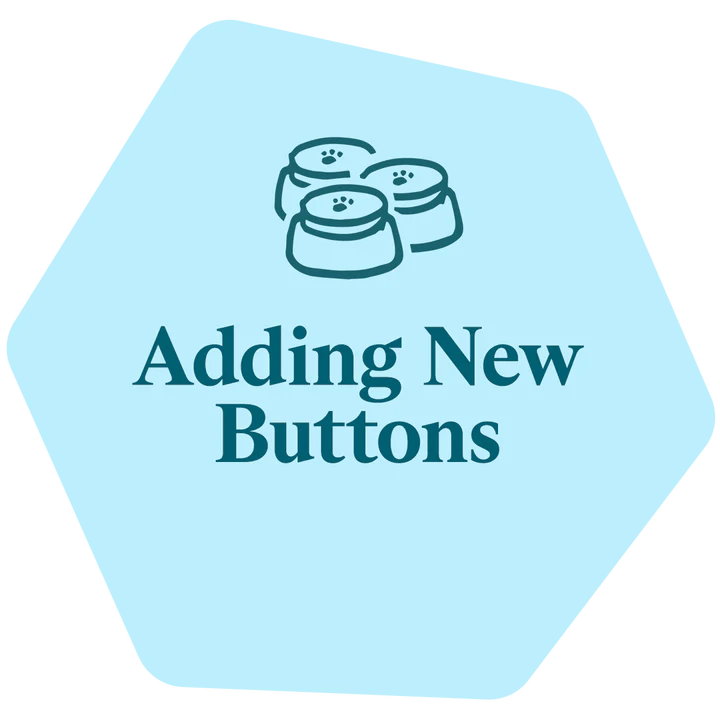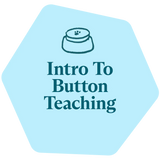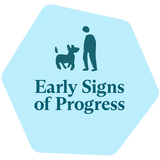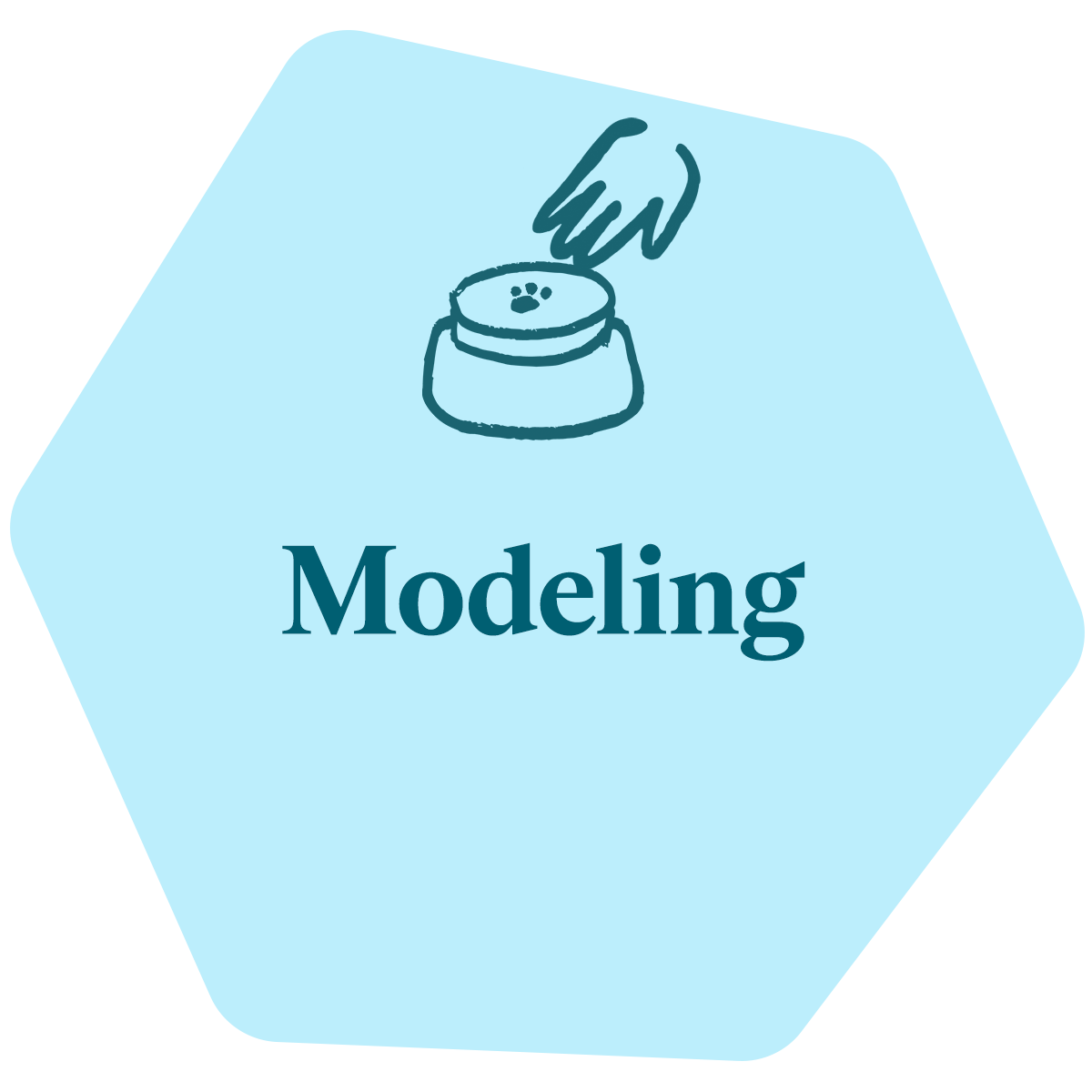is able to & does press buttons regularly
understands pressing a particular button relates to a specific concept (OUTSIDE = go outside & SCRITCHES = get pets)
seems to understand the meaning of buttons they already have
Don’t expect your learner to use every button equally. They will use some buttons more than others and others they’ll hardly use at all. Just because your learner doesn’t use a button doesn’t mean they don’t understand it. They simply may not have the need or desire to use it regularly. Watch their reactions carefully when you press and model this button. Does it seem like they get it?
WAIT to add buttons
If your learner is still not pressing buttons on their own → begin target training
If your learner is indiscriminately pressing multiple buttons and expecting the same result (e.g. all of them mean TREAT) → spend more time modeling their current concepts before moving on
When to Add New Buttons
Once you’ve got the basics down with your learner and begin gradually adding new buttons, you’ll become more familiar with their individual learning pace. In the meantime, look for the following signs that it may be time to add new buttons.It might be time to add new buttons if your learner does any of the following:
- Presses their current buttons regularly in ways that make sense
- Clearly tries to communicate something beyond their current buttons
- Has to use natural behavior combined with buttons in order for you to understand
- Has inexplicably lost interest in using their soundboard
They press their current buttons regularly in ways that make sense
If your learner is pressing regularly in ways that make sense, this means they’re comfortable with their current button repertoire. You may notice your learner regularly favoring some buttons over others. This is normal––they will use some buttons more than others. Just because your learner doesn’t use a button doesn’t mean they don’t understand it. If they understand the current concepts available to them, you can continue adding new buttons at their pace.
They clearly try to communicate something beyond their current buttons.
If your learner has started using the same button to mean multiple things or if they’re combining words to describe something they don’t have a button for, they might need more accurate words to reference these things.
They have to use natural behavior combined with buttons in order for you to understand
It’s great if they prefer to mix buttons and natural behavior as part of their personal communication style. However, if that’s the only way they can get you to understand, it’s probably time to give them more ways to express themself with additional buttons.
They have inexplicably lost interest in using their soundboard
Learners go through natural talkative and quiet stages, which can be influenced by a variety of environmental and life factors. But if they’re going through a period of disinterest in their buttons with no obvious explanation (surgery, heat cycle, health issues, home life changes, vacation, etc), it may be time to add new buttons and reignite their interest in the soundboard. Before automatically adding new buttons, make sure you haven’t made any recent changes to the soundboard layout or location which might be the real culprit behind discontinued use. Rearranging furniture or the room the soundboard is in can affect their use of it as well.
How to Add New Buttons
Introduce 1-2 buttons at a time. It can be exciting to introduce new words but avoid the temptation to introduce too many at once. We recommend adding only 1 or 2 new buttons at a time so they have a chance to properly learn new concepts before further soundboard expansion.
Remember, mistakes happen. It’s okay to take two steps back in order to move forward. If you realize you accidentally introduced too many concepts too soon, retract the most recent ones and wait until your learner seems ready to reintroduce them.
Any soundboard changes are best done gradually. This includes adding buttons, moving buttons, changing buttons, and rearranging HexTiles. Some learners are more disturbed or upset by abrupt changes to their soundboard than others
Avoid making changes to their soundboard and introducing new concepts at the same time. When things get moved or changed, they’ll probably have to focus on relearning their locations which involves increased modeling and experimentation just as though the concepts were brand new. Multiple new concepts at the same time may be counterproductive.
Adding naturally paired or contrasting concepts at the same time might help them understand and differentiate the meaning of both.
For example: NOW/LATER, YES/NO, OUT/IN, UPSTAIRS/DOWNSTAIRS, HI/BYE, HAPPY/MAD, TUG/BALL
Tips for Picking Buttons
What are the best words to add to my learner’s soundboard?- Motivating or relevant to your learner
- Concepts that are familiar, predictable, frequent, and functional
- Social words, like attention getters, family members, and their own names
- Useful across multiple concepts, or can be used with other words (e.g., want, help, more)
Examples: OUTSIDE, WALK, DINNER, BRUSH TEETH, BEDTIME
Social words like attention getters, family members, and their own names, are also very relevant to your daily lives. You’ll need to begin referring to yourself and others with the word you want your learner to associate with them. And yes, that does mean talking about yourself in the third person to your learner if you live alone.
Examples: MOM, DAD, HI, BYE, LOVE YOU
Examples: WANT, HELP, MORE, YES, NO, ALL DONE
Did you know? Using their own name as a button may be a slightly more advanced concept than you might think. Toddlers don’t begin referring to themselves by name until they’re around 2 years old and have already been consistently using 2-3 word phrases.
Use our Future Button Brainstorm activity to help you keep track of buttons you may want to add for your learner someday.
Reminder: You can pick any word(s) to mean any concept. This is about building a shared dictionary with your learner. It may be easier to properly expose them to words you and those around you already regularly use, but that doesn’t mean you’re restricted to those. As long as you’re consistent and clear about a word’s meaning, it can be anything you want.
If you have questions or feedback regarding this content, please email us at learning@fluent.pet














Leave a comment
This site is protected by hCaptcha and the hCaptcha Privacy Policy and Terms of Service apply.